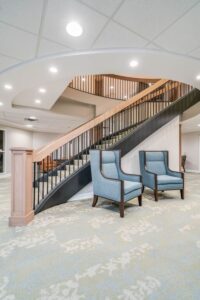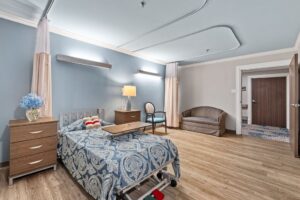Photo: Flooring that minimizes slip risk, supports stable movement, and clearly defines transitions gives residents the confidence to move independently.
By Sandi Soraci, EDAC, LEED AP, NCIDQ, IIDA, RCR
Flooring isn’t just a design decision—it’s a care decision. In senior living environments, every surface plays a role in how residents experience their day. The right flooring can encourage mobility, support emotional well-being, reduce caregiver strain and prevent serious injury. It’s the foundation—literally and figuratively—for safe, supportive and beautiful aging-in-place.
As designers, operators, and specifiers, we have a responsibility to move beyond aesthetics or cost alone. We must ask:
- Will this floor help someone feel confident taking that next step?
- Will it calm a person who’s confused or overstimulated?
- Will it support the staff who show up every day to care for others?
If we consider those questions, we won’t just be creating interiors—we’ll be helping people age with dignity, safety, and joy.
Designing for an Aging Population

Photo Credit (all): Courtesy of Tarkett
When designing for aging populations, it is important to specify interior finishes that can foster cognitive, emotional, physical and visual acuity. The right flooring specification is critical to reducing falls (the leading cause of injury for adults aged 65 and older, according to the CDC) and improving safe mobility. Characteristics like type of surface, pattern, color contrast, reflectivity, cushioning, acoustics and slip resistance all have an actionable impact on occupant safety.
Beyond physical safety, flooring elements can influence behaviors among memory care residents, too, as challenges with visual perception can cause elevated levels of confusion or fear. Additionally, color can modulate and even preclude challenging behaviors associated with dementia.
Flooring is one of the most critical design elements in senior living and life plan communities because it quite literally supports every step residents take—physically, cognitively and emotionally.
As people age, changes in vision, hearing, balance, and mobility can dramatically affect how they perceive and navigate their environment. The right flooring can enhance safety, support independence, reduce anxiety and improve overall well-being.
Here’s why it matters:
- Falls are the leading cause of injury among older adults, and flooring plays a direct role in either preventing or contributing to those incidents. Slip resistance, cushioning, and transitions between surfaces can make the difference between confident movement and a dangerous fall.
- Sensory changes—such as diminished vision or altered depth perception—can make certain flooring patterns or colors disorienting. A pattern that’s too busy or highly contrasted can appear distorted or even threatening to someone with dementia, while poor lighting combined with reflective finishes can look slippery or confusing.
- Cognitive decline, especially in memory care settings, makes wayfinding and orientation essential. Flooring that helps visually define spaces or guide movement can reduce confusion, agitation and fear.
- Acoustic performance is also key. Hard flooring surfaces can create noisy environments that overwhelm residents with hearing loss or cognitive sensitivity. Using soft, sound-absorbing flooring materials in appropriate areas can make spaces feel calmer and more comfortable.
Health and Safety
Choosing the wrong flooring product in senior living environments can have serious health and safety implications, some of which may not be immediately obvious. Here are several key risks:
Increased Fall Risk
Falls are the most common cause of injury among older adults—and a leading reason for emergency room visits. More than 14 million (1 in 4) older adults fall every year, resulting in a cumulative $50 billion spent annually. Flooring with overly smooth or glossy finishes can be slippery, especially in wet areas like bathrooms or entryways. On the other hand, flooring that’s too soft or heavily cushioned may affect gait stability or make it difficult to use mobility aids like walkers and wheelchairs. Choosing the right flooring can reduce the number of falls in a space.
Visual Disorientation and Confusion

Aging eyes and neurocognitive changes (such as dementia) can distort how residents perceive color, pattern and depth. High-contrast patterns, bold geometric designs, or dark mats and floor accents may appear as holes, steps or objects—causing hesitation, fear or falls. If the flooring doesn’t support visual clarity, residents may limit their own mobility out of anxiety or confusion.
Cognitive Overload
People with dementia or mild cognitive impairment are more sensitive to overstimulation. Busy floor patterns, clashing colors, or unexpected surface changes can cause agitation, disorientation or even aggressive behaviors. Flooring should reduce cognitive “noise,” not add to it.
Poor Acoustics and Noise-Related Stress
Hard, reflective surfaces can amplify noise, creating environments that are uncomfortable and disorienting—particularly for residents with hearing loss or dual sensory impairments (both vision and hearing). Elevated noise levels are also linked to increased fall risk, reduced communication and sleep disruption.
Compromised Hygiene and Infection Control
Porous or difficult-to-clean flooring can trap moisture and bacteria, leading to sanitation concerns—especially in shared or healthcare-adjacent spaces. Flooring should support easy cleaning, resist moisture intrusion and meet healthcare-grade hygiene standards.
Barrier to Independence
If transitions between flooring surfaces are not smooth—or if materials are incompatible with assistive devices—residents may struggle with movement and lose confidence. Flooring that inhibits rollability or presents physical thresholds can restrict access to daily activities and social spaces, which impacts both physical and emotional health.
Enhancing the Experience
For aging individuals, especially those experiencing neurocognitive and sensory challenges, thoughtfully designed spaces can significantly influence quality of life. One’s built environment plays active and passive roles in shaping their functional independence, enhancing their sensory perception, and preserving their sense of community and connection.
For residents, here are some specific ways flooring can enhance their experience.
Safety = Confidence
Flooring that minimizes slip risk, supports stable movement, and clearly defines transitions gives residents the confidence to move independently. That independence is key to maintaining dignity, reducing reliance on staff and encouraging participation in daily life.
Sensory Comfort
The right flooring can soften sound, minimize glare, and provide a sense of warmth underfoot. For residents with cognitive impairment or heightened sensitivity, a calming environment—free of jarring noises or visual confusion—can dramatically improve emotional well-being and reduce anxiety.
Wayfinding and Orientation
Flooring can help with intuitive navigation through the use of color cues and contrast. For example, subtle floor color changes can signal a shift from public to private spaces, or help define pathways and activity zones. This supports residents with memory loss or reduced spatial awareness.
Emotional Connection
Warm, residential aesthetics that mimic home-like materials—rather than cold, institutional finishes—foster comfort, familiarity, and pride of place. Flooring helps set the tone for an environment that feels welcoming and emotionally supportive, which is critical for older adults adjusting to new living arrangements.
Aside from physical implications, the right flooring can have positive impact on cognitive functions. Color selection alone is critical:
- Blue is restful, calming, and lowers blood pressure and anxiety.
- Green is the most restful of all the colors and can lower central nervous system activity.
- Red stimulates brain activity, which can be useful in activity or dining rooms.
- For those with Lewy Body Dementia, black is perceived as scary or intimidating from the kneecap down. For instance, a black entry mat may be perceived as a hole and an unwelcome space to enter.
Color contrast also factors into safety and mobility. High contrast between the floors and walls helps define the pathway and isolate hazards. Low contrast between adjacent floors encourages movement between rooms.
Watch for Part II of this article in next week’s edition of Healthcare Construction and Operations News, which will explore how flooring choices can also improve the employee experience and reduce maintenance needs while helping facilities meet sustainability goals.
Sandi Soraci, EDAC, LEED AP, NCIDQ, IIDA, RCR, is director of healthcare and senior living strategies for Tarkett North America.


